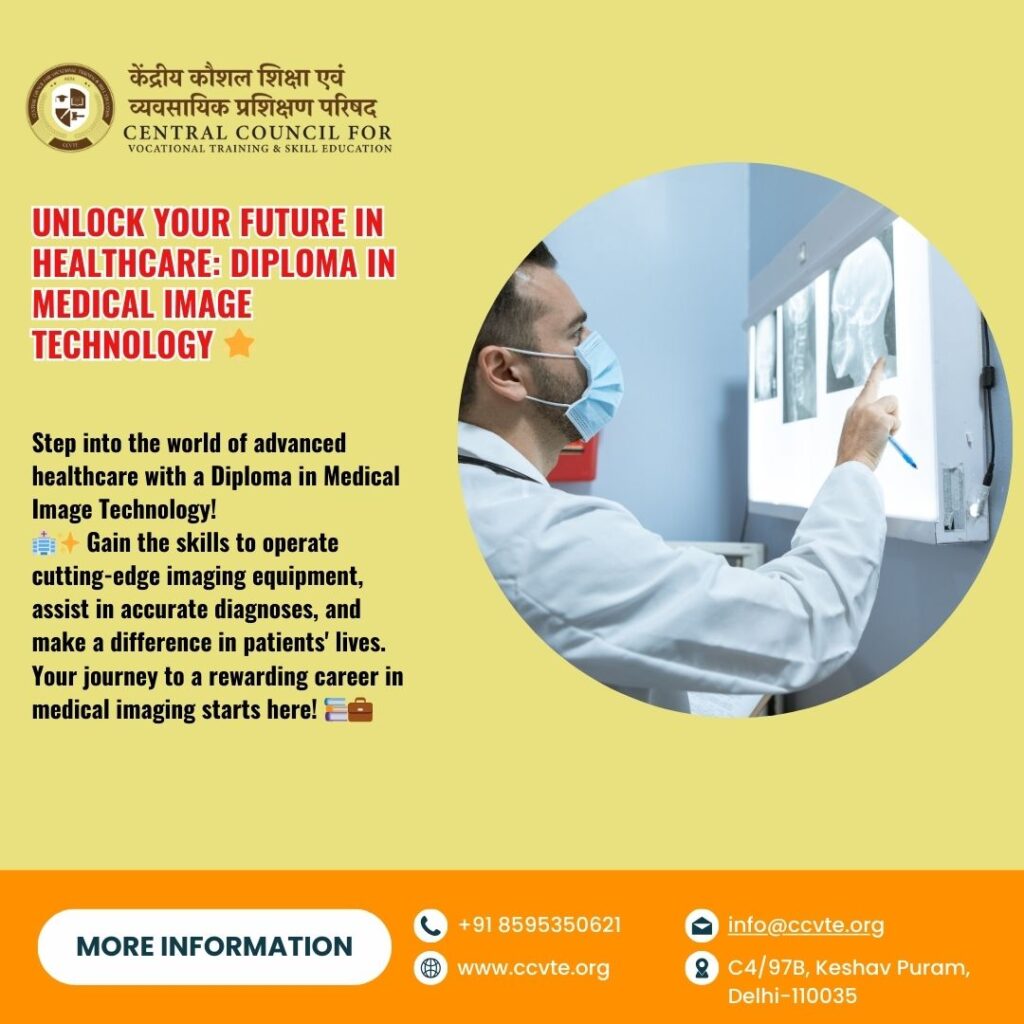Medical image technology is an essential field within healthcare that combines advanced technology with patient care to provide accurate diagnoses. It involves the use of various imaging tools, such as X-rays, MRIs (Magnetic Resonance Imaging), CT scans (Computed Tomography), and ultrasounds, to create detailed images of the body’s internal structures. These images help doctors identify and treat medical conditions such as fractures, tumors, cardiovascular diseases, and neurological disorders. As healthcare continues to evolve, the demand for skilled medical imaging professionals is growing, offering exciting career prospects in this dynamic and rewarding field.
For those looking to enter the field, obtaining a Diploma in Medical Image Technology can be an excellent pathway to starting a successful career. The CCVTE (Certified Centre for Vocational and Technical Education) offers a specialized Diploma in Medical Image Technology, providing students with both theoretical knowledge and hands-on training in various imaging modalities. This diploma program equips students with the skills needed to operate advanced imaging equipment, understand safety protocols, and deliver quality patient care. The curriculum is designed to ensure that graduates are ready to enter the workforce with the expertise required to meet the demands of the healthcare sector.
One of the key benefits of a Diploma in Medical Image Technology is that it opens up multiple career paths within the medical imaging field. After completing the program, graduates can choose to specialize in a variety of imaging modalities, depending on their interests and career goals. For example, they can focus on areas such as:
- X-ray Technologist: Specializing in traditional X-rays, which are commonly used to diagnose bone fractures, infections, and other conditions.
- MRI Technologist: Operating MRI machines to produce detailed images of soft tissues, such as the brain, muscles, and internal organs.
- CT Technologist: Working with CT scanners to create cross-sectional images of the body, helping doctors detect internal injuries, tumors, and other conditions.
- Ultrasound Technologist: Using ultrasound equipment to visualize internal organs and monitor the health of a fetus during pregnancy.
Each of these specialties offers excellent career prospects, with the potential for further advancement as individuals gain experience and expertise in their chosen field. The demand for skilled professionals in medical imaging is on the rise due to technological advancements and the increasing reliance on imaging in healthcare. As a result, job opportunities are plentiful in hospitals, diagnostic centers, research facilities, and outpatient clinics.
The field of medical imaging also offers job stability and competitive salaries. According to labor market trends, the healthcare sector is one of the fastest-growing industries worldwide, and medical imaging is no exception. As the population ages and the need for diagnostic imaging increases, there is a growing demand for trained medical imaging professionals. Additionally, as healthcare providers continue to adopt cutting-edge imaging technologies, the need for individuals who can operate these tools is crucial. This demand translates into a stable job market with opportunities for growth.
Furthermore, graduates with a Diploma in Medical Image Technology from institutions like CCVTE have the advantage of hands-on training with modern equipment. This practical experience, combined with a solid understanding of imaging principles, ensures that graduates are well-prepared for real-world challenges. Employers highly value the ability to use and maintain advanced imaging technologies, and the diploma program ensures students have the expertise to meet these requirements.
In addition to job security and competitive salaries, career growth in medical imaging is highly achievable. Many professionals in the field pursue advanced certifications or further education to specialize in specific imaging technologies, which can lead to higher-level positions and increased earning potential. For example, after working as a general radiologic technologist, one might pursue certifications in MRI or CT, which could open doors to more specialized roles or management positions.
Moreover, medical imaging professionals often enjoy flexible working hours and opportunities for continued education and training. Many professionals work in hospitals, where they may have the option of shift work, providing them with a better work-life balance. Additionally, the healthcare industry encourages lifelong learning, with opportunities to attend workshops, seminars, and courses that keep professionals up to date with the latest technological advancements.
The personal satisfaction that comes with a career in medical imaging is another reason why this field is appealing. Medical imaging professionals play a critical role in helping to diagnose diseases and conditions, often leading to early detection and better treatment outcomes. This sense of purpose and the ability to contribute to patient care makes medical imaging a fulfilling career choice.
In conclusion, a career in medical image technology offers a wealth of opportunities. With a skill development courses from CCVTE, graduates are well-equipped to embark on a fulfilling and stable career in a growing field. Whether pursuing a specialized role in MRI, CT, or ultrasound, or working in general radiology, the career prospects in medical imaging are abundant, offering job security, competitive salaries, and the chance to make a positive impact on healthcare.


